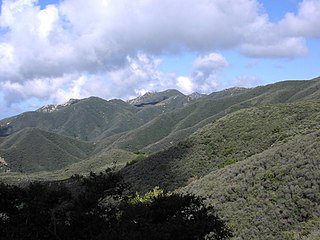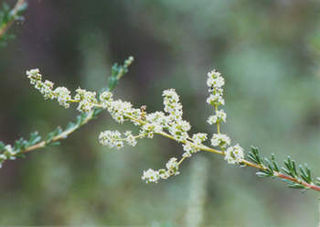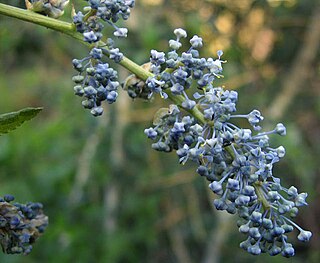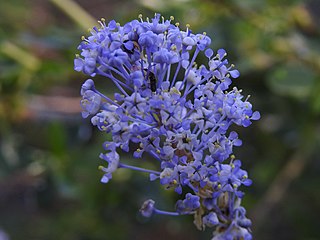
Chaparral is a shrubland plant community found primarily in California, in southern Oregon and in the northern portion of the Baja California Peninsula in Mexico. It is shaped by a Mediterranean climate and infrequent, high-intensity crown fires.

Ceanothus is a genus of about 50–60 species of nitrogen-fixing shrubs and small trees in the buckthorn family (Rhamnaceae). Common names for members of this genus are buckbrush, California lilac, soap bush, or just ceanothus. "Ceanothus" comes from Ancient Greek: κεάνωθος (keanōthos), which was applied by Theophrastus to an Old World plant believed to be Cirsium arvense.

Adenostoma fasciculatum, commonly known as chamise or greasewood, is a flowering plant native to California and Baja California. This shrub is one of the most widespread plants of the California chaparral ecoregion. Chamise produces a specialized lignotuber underground and at the base of the stem, known as a burl, that allow it to resprout after fire has off burned its stems. It is noted for its greasy, resinous foliage, and its status as one of California's most iconic chaparral shrubs.

Ceanothus integerrimus, known by the common name deer brush, is a species of woody shrub in the family Rhamnaceae, native to the western United States in Arizona, New Mexico, California, Oregon, and Washington. It grows in montane chaparral and woodlands regions, in hardwood forests, and in fir, spruce, and Ponderosa pine plant communities, being most abundant in the California chaparral and woodlands and Sierra Nevada.

Eriodictyon capitatum, the Lompoc yerba santa, is a rare evergreen shrub in the borage family. It is endemic to western Santa Barbara County, in California.

Ceanothus cuneatus is a species of flowering shrub known by the common names buckbrush and wedgeleaf ceanothus.

Ceanothus ophiochilus is a rare species of flowering shrub known by the common name Vail Lake ceanothus, native to Southern California. It was not described until 1991.

Ceanothus confusus is a species of shrub in the family Rhamnaceae known by the common name Rincon Ridge ceanothus. It is endemic to northern California where it grows in the coastal mountains north of the San Francisco Bay Area. Its habitats include coniferous forest, woodland, and chaparral. This is a low, spreading shrub often forming a short mat up to about 1.2 meters wide. The stem is gray-brown with new twigs having a reddish color and fuzzy texture. The evergreen leaves are oppositely arranged. Each is up to 2 centimeters long and oval in shape with 3 to 5 large teeth. The upper surface is shiny green and the underside is paler and feltlike in texture with hairs along the veins. The inflorescence is a small cluster of blue or purple flowers. The fruit is a horned capsule about half a centimeter wide.

Ceanothus ferrisiae is a rare species of shrub in the family Rhamnaceae. Its common name is coyote ceanothus.

Ceanothus incanus is a species of shrub in the family Rhamnaceae known by the common name coast whitethorn. It is endemic to California, where it is known from the San Francisco Bay Area through the North Coast Ranges into the Klamath Mountains.

Ceanothus leucodermis, with the common names chaparral whitethorn or chaparral white thorn, is a species of shrub in the family Rhamnaceae. This Ceanothus is an importance browse for several types of ungulate, such as the mule deer and bighorn sheep, who prefer the new growth and shoots to the older, spiny parts.

Ceanothus parvifolius is a species of shrub in the family Rhamnaceae known by the common name littleleaf ceanothus or littleleaf whitethorn. This deciduous plant is characterized by its blue flowers and flat topped habit, and is endemic to the Sierra Nevada of California, where it grows on mountain flats and coniferous forest.

Ceanothus prostratus is a species of shrub in the family Rhamnaceae. Common names include prostrate ceanothus, pinemat, and mahala mat. It is native to the Pacific Northwest of the United States where it grows in coniferous forests and open plateaus.

Ceanothus pumilus is a species of shrub in the family Rhamnaceae known by the common names dwarf ceanothus and Siskiyou mat.

Ceanothus roderickii is a rare species of shrub in the family Rhamnaceae known by the common name Pine Hill ceanothus. It is endemic to western El Dorado County, California, where it grows in the chaparral and woodlands of the Sierra Nevada foothills, such as the Pine Hill Ecological Reserve. It is named after 20th century California flora explorer, botanist, and arboretum director Wayne Roderick.

Ceanothus sanguineus is a species of shrub in the family Rhamnaceae known by the common name redstem ceanothus. It is native to western North America from British Columbia to Montana to far northern California; it is also known from Michigan. It grows in temperate coniferous forest habitat in forest openings amidst the conifers. This is an erect shrub approaching 3 meters in maximum height. Its stem is red to purple in color, its woody parts green and hairless when new. The deciduous leaves are alternately arranged and up to about 10 centimeters long. They are thin, light green, oval, and generally edged with glandular teeth. The undersides are sometimes hairy. The inflorescence is a cluster of white flowers up to about 12 centimeters long. The fruit is a three-lobed smooth capsule about 4 millimeters long. This shrub is an important food plant for wild ungulates such as the Rocky Mountain Elk, it is browsed eagerly by many types of livestock, and the seed is consumed by many types of animals.

Ceanothus velutinus, with the common names snowbrush ceanothus, red root, tobacco brush, and sticky laurel, is a species of shrub in the family Rhamnaceae. It is native to western North America from British Columbia to California to Colorado.

Ceanothus verrucosus is a species of shrub in the family Rhamnaceae known by the common names wart-stem ceanothus, barranca brush, coast lilac and white coast ceanothus. It is endemic to northwestern Baja California and San Diego County, where it grows in coastal sage scrub and coastal succulent scrub habitats. It is considered a rare species north of the international border, as most of the valuable coastal land that hosts this plant in the San Diego area has been claimed for development. In California, several extant populations still remain scattered around the region, such as one protected at Torrey Pines.

Ceanothus herbaceus, also known as Jersey tea, is a species of shrub in the family Rhamnaceae and is similar to Ceanothus americanus and Ceanothus sanguineus. It is a perennial shrub which is native to North America.

Rhytidiadelphus loreus, also commonly known as lanky moss and Little Shaggy Moss, is a nonvascular "feather moss" species that is a key component of a healthy, thriving forest ecosystem. Lanky moss grows in North America, Canada and Europe. It is primarily a coastal species that grows in moist, coniferous and deciduous forests, acidic grasslands and in the UK, heathy slopes on mountains. It grows on decaying logs, the forest floor and as an epiphyte on living trees. Its key functions in the ecosystem are water retention and temperature insulation.





















